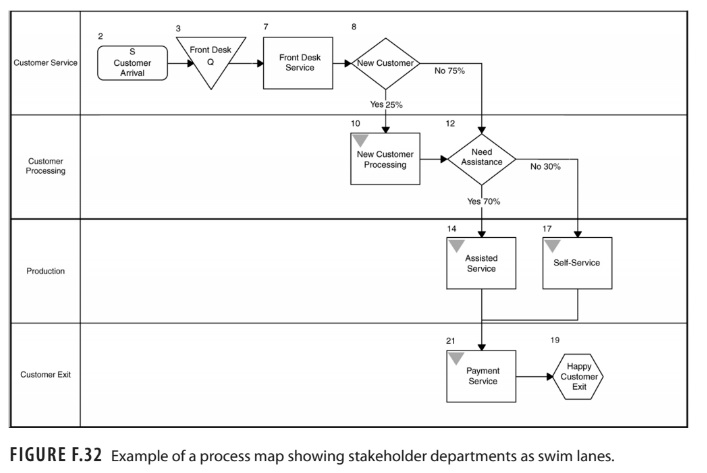Tools
7MP Management and Planning Tools
8QC Traditional Quality Control Tools
Failure Mode, Effects, and Criticality Analysis
Maintainability and Availability
Process Decision Program Charts
PROCESS MAPS
The following is an excerpt on Six Sigma implementation and the Six Sigma steps from Six Sigma Demystified (2011, McGraw-Hill) by Paul Keller.
Similar to a flowchart, a process map is a simple graphic tool for documenting the flow (the series of steps necessary) of a process. Six Sigma process mapping can be used to display the value stream and even the movement of materials (including such information as in a service process) so that each step and movement can be analyzed for value creation. Often, 'swim lanes' can be used on a process map to indicate movement into functional departments. Cycle times also may be included to assist in the analysis.
When to Use
Define Stage
Measure Stage
Analyze Stage
Improve Stage
Control Stage
Methodology
As in the flowchart, each task will be represented by a symbol. ANSI standard symbols may be used, but most practitioners use rectangles for most tasks and diamonds for decision tasks. Decisions should have only two outcomes (yes or no), so decision points must be phrased in this manner.
We can use Six Sigma process mapping to document the current (as-is) process. See Figure F.32. We can use symbol shade or shape to indicate process delays, functional responsibility for each step (e.g., the small gray inverted triangle is customer service), or points in the process where measurements are taken.
Location of process steps on the map is indicated by swim lanes, used to indicate physical layout, responsible department, stakeholder, schedule, or other condition for each process activity.
Figure F.32 is an example of Six Sigma process mapping using Sigma Flow software. In this case, the swim lanes provide an indication of department responsible (i.e., customer service, customer processing, or production).
Interpretation
A quick review of the as-is process usually can uncover complexities in the form of an excessive number of decision points and branches that may contribute to delays or even defects. When used to document the future (desired) process, we strive to make process flow uncomplicated, with the fewest symbols (tasks) and branches possible. This lack of complexity in the process will tend to reduce the number of errors.

Learn more about the Quality Improvement principles and tools for process excellence in Six Sigma Demystified (2011, McGraw-Hill) by Paul Keller, or his online Green Belt certification course ($499).





